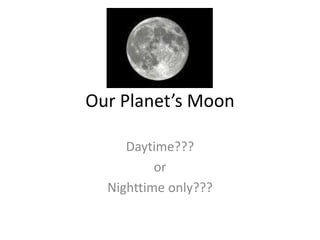
Our Planet’S Moon
- 1. Our Planet’s Moon Daytime??? or Nighttime only???
- 2. Definitions Reflective—physically capable of returning/ reflecting light or sound (Ex. mirrors have reflective properties) Lighter colors (white and grey) have the ability to reflect more light than dark colors
- 8. The moon’s ability to be seen The moon is not a star with it’s own light source. Then why is it so bright? The moon’s color has reflective properties that allow us to see light from the sun being reflected When can we see the moon? It is easiest seen at night because the sky is so dark allowing the sun’s reflection to stand out It can also be seen during the day depending on its position in relation to the sun and the Earth (Extension Activity: Observe the moon over the period of one month and write down details about what you see and/or draw pictures on the Lunar Sighting worksheet included in the box.)
- 10. Take note of their color.
- 12. You will need to do this with the lights in the room off and then again with the lights on.
- 14. Main ActivityCan you see its reflection? With the room lights off, turn on the flash light (sun). Make observations Slowly turn the foam shoe (remember mirror faces the Earth.) Make observations Continue this process until you have rotated the Earth and Moon 360* Do the above steps with the lights on now.
- 16. Was it easier to see the reflection with the lights on or with the lights off?
- 18. See a recording of the moon during the daytime. http://www.youtube.com/watch?v=ovLzyFeZJJE&NR=1 In the picture at right you can see the sun is just beginning to rise over the water in the far right of the picture. The moon is what is seen already in the sky to the far left. In the picture at left you can see the sun is full and low to the horizon. The moon is large and high in the sky. The moon is in its crescent shape.
- 19. Teacher Reference SectionIndiana State Standard 4.3.1 Observe and report that the moon can be seen sometimes at night and sometimes during the day. http://dc.doe.in.gov/Standards/AcademicStandards/StandardSearch.aspx http://www.indianastandardsresources.org/files/sci/sci_4_3_1.pdf
- 20. Materials in BoxTotal of 2 complete sets Instructor’s Demonstration Items: Complete solar system model Pictures of bicycle with reflector bright white Lunar Sighting worksheet http://www.indianastandardsresources.org/files/sci/sci_4_3_1.pdf Introduction Activity: Notebook paper Red reflector Orange reflector Round mirror Flashlight (use for both activities) Main Activity: Notebook paper Round styrofoamdisc or foam flip flop Styrofoam moon on a dowel Styrofoam Earth on a dowel
- 22. Apply what you learned about reflectors to determine why bicycles, pedestrians, and joggers need to have reflectors or reflective material on?
- 23. Based on the moon activity and what you learned about color and reflective things, what else can people do or wear besides reflective materials?